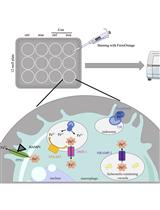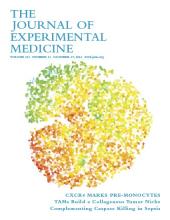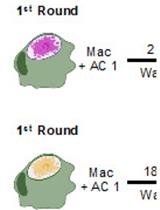- EN - English
- CN - 中文
Creating a RAW264.7 CRISPR-Cas9 Genome Wide Library
创建RAW264.7 CRISPR-Cas9全基因组文库
发布: 2017年05月20日第7卷第10期 DOI: 10.21769/BioProtoc.2320 浏览次数: 13729
评审: Ivan ZanoniAnonymous reviewer(s)

相关实验方案

在平板检测仪中使用高特异性荧光探针定量巨噬细胞细胞二价铁 (Fe2+) 含量
Philipp Grubwieser [...] Christa Pfeifhofer-Obermair
2024年02月05日 2184 阅读

研究免疫调控血管功能的新实验方法:小鼠主动脉与T淋巴细胞或巨噬细胞的共培养
Taylor C. Kress [...] Eric J. Belin de Chantemèle
2025年09月05日 3505 阅读
Abstract
The bacterial clustered regularly interspaced short palindromic repeats (CRISPR)-Cas9 genome editing tools are used in mammalian cells to knock-out specific genes of interest to elucidate gene function. The CRISPR-Cas9 system requires that the mammalian cell expresses Cas9 endonuclease, guide RNA (gRNA) to lead the endonuclease to the gene of interest, and the PAM sequence that links the Cas9 to the gRNA. CRISPR-Cas9 genome wide libraries are used to screen the effect of each gene in the genome on the cellular phenotype of interest, in an unbiased high-throughput manner. In this protocol, we describe our method of creating a CRISPR-Cas9 genome wide library in a transformed murine macrophage cell-line (RAW264.7). We have employed this library to identify novel mediators in the caspase-11 cell death pathway (Napier et al., 2016); however, this library can then be used to screen the importance of specific genes in multiple murine macrophage cellular pathways.
Keywords: CRISPR (CRISPR)Background
Historically, understanding the contribution of specific genes to phenotypes of interest in eukaryotic cells was possible using RNA interference (RNAi) or cells derived from knockout mice. However, within the last few years the new genome editing technique CRISPR-Cas9 has allowed for easy and efficient generation of knockout cell lines and genome-wide screens within eukaryotic cells. CRISPR-Cas9 genome-wide screens have expanded the toolbox for mammalian genetics and for the identification of novel proteins and their contributions to specific phenotype. Using this method, researchers have been able to identify novel genes involved in tumor growth (Chen et al., 2015; Kiessling et al., 2016; Steinhart et al., 2017), microbial entry and replication (Popov et al., 2015; Marceau et al., 2016), cell death pathways (Shi et al., 2015; Napier et al., 2106), and much more. Here we harness the CRISPR-Cas9 system, to create a genome-wide knockout library in a murine macrophage cell line. Macrophages are the crux of many innate immune responses to invading pathogens or danger signals. By creating a genome-wide knockout library in macrophages we can now begin to identify novel mediators of these innate immune responses to identify novel diagnostic and therapeutic targets for acute and chronic inflammation.
Materials and Reagents
- Pipette tips
- 10 cm bacteriological tissue culture (TC) treated Petri dish (Corning, Falcon®, catalog number: 353003 )
- 6-well plates TC treated (Corning, Costar®, catalog number: 353502 )
- 15 ml Falcon tube (E&K Scientific Products, catalog number: EK-4020 )
- 50 ml Falcon tube (E&K Scientific Products, catalog number: EK-4023 )
- Cell scraper (SARSTEDT, catalog number: 83.1830 )
- 0.45 μm syringe filters (Corning, catalog number: 431225 )
- T-75 flask (Corning, Falcon®, catalog number: 353136 )
- T-125 flask (Corning, Falcon®, catalog number: 353112 )
- Cryovials (Corning, catalog number: 430659 )
- RAW264.7 cells (ATCC, catalog number: TIB-71 )
- 293T cells (ATCC, catalog number: CRL-3216 )
- hCas9 plasmid (Addgene, catalog number: 52962 )
- FuGene (Promega, catalog number: E2311 )
- VSV-G (Addgene, catalog number: 8454 )
- pAdVAntage (Promega, catalog number: E1711 )
- △VPR (Addgene; catalog number: 8455 )
- Genome-wide Mouse lentiviral CRISPR gRNA library v1 (Addgene, catalog number: 50947 )
- Filtered DMEM (Thermo Fisher Scientific, GibcoTM, catalog number: 11995073 )
- Filtered (0.2 μm filter) heat-inactivated (30 min at 37 °C) FBS (Thermo Fisher Scientific, GibcoTM; stock specific)
- Protamine sulphate (Sigma-Aldrich, catalog number: P3369-10G ), keep stock at 8 mg/ml at 4 °C
- Blasticidin hydrochloride (MP Biomedicals, catalog number: 02150477-25 mg ), keep aliquoted stock at 10 mg/ml at -20 °C
- DMSO (Fisher Scientific, catalog number: BP231-100 )
- Puromycin dihydrochloride from Streptomyces alboniger (Sigma-Aldrich, catalog number: P8833 )
- RAW264.7 and 293T tissue culture media (see Recipes)
- Blasticidin selection media (see Recipes)
- Puromycin selection media (see Recipes)
- Tissue culture freezing media (see Recipes)
Equipment
- Pipettes
- Fluorescence microscope that can visualize BFP
- Incubator at 37 °C with 5% CO2
- Centrifuge
Procedure
文章信息
版权信息
© 2017 The Authors; exclusive licensee Bio-protocol LLC.
如何引用
Napier, B. A. and Monack, D. M. (2017). Creating a RAW264.7 CRISPR-Cas9 Genome Wide Library. Bio-protocol 7(10): e2320. DOI: 10.21769/BioProtoc.2320.
分类
免疫学 > 免疫细胞功能 > 巨噬细胞
分子生物学 > RNA > 转染
您对这篇实验方法有问题吗?
在此处发布您的问题,我们将邀请本文作者来回答。同时,我们会将您的问题发布到Bio-protocol Exchange,以便寻求社区成员的帮助。
Share
Bluesky
X
Copy link









